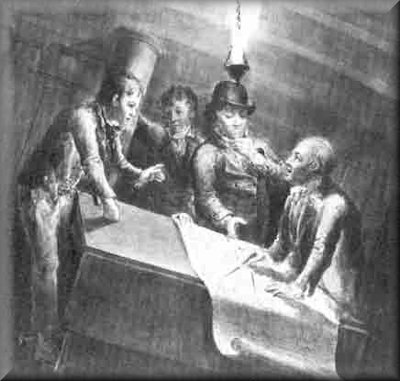‘Schoolies’: Teachers of the Royal Navy and Royal
Marines 1700-1914
From 1729 to 1816, he was rated a college volunteer (a graduate of the Royal Naval Academy/ College, dealt with further in these writings). To fit the volunteer per order and college volunteer into the system, the rate of ordinary midshipman existed. The latter was a supernumerary, paid as an able seaman and occupying the position of the same within a ship’s hierarchy, however, his time counted toward the qualifying time for lieutenant. Examinations were the tools used to weed unqualified individuals from the promotional garden of lieutenants. Over time, as educational institutions of the Royal Navy were founded and evolved, one’s birth and influence were tempered with the requirement to pass an examination in order to gain promotion and thus point the way to higher command. Admittedly, however, the latter was attained through a combination of practical skill and patronage, rather than knowledge gleaned from the page. Still, ‘book learning’ formed a base upon which to build a future. Though the first reference to a naval educator (dubbed an ‘ingenious person’) appeared in the Order-in-Council of Queen Anne (14 March 1702), the official title of ‘schoolmaster’ was not present in this order. A decade later, Admiralty warrants included the term ‘schoolmaster’ for the first time, but alas, applied no official designation. In fact, the schoolmaster was an inferior warrant officer without an official title, who received the pay of an ordinary midshipman. Since he was appointed by the captain, his professional and social status on board amounted to that of a petty officer without a uniform. Indeed, ships’ captains would influence the overall provision of education for decades to come. In terms of crossing palms with silver, Queen Anne’s Order-in-Council did sweeten the pockets of would-be seagoing teachers by eventually offering a bounty of £20 per annum for service in ships of the first through sixth rates, in addition to an ordinary midshipman’s pay. However, before any British captain could consider taking on a schoolmaster, that individual must have shown proof of qualification from the Corporation of Trinity House at Deptford, in addition to producing a certificate ‘under the hands of Good Substantial People that he is of Sober Life and Conversation’. The Trinity House certificate spoke of competency in navigation but did nothing to address the holder’s ability to teach. Actual teacher training did not begin in the Royal Navy until well into the 19th century The schoolmaster cometh!
Another example of a schoolmaster attaining his lieutenancy is illustrated by John McKerlie’s NGS. He was a quarter gunner (petty officer) for the ‘INDEFATIGABLE 20 APRIL 1796’ clasp, then schoolmaster for ‘INDEFATIGABLE 13 JAN. 1797’ and, finally, Lieutenant in Spartiate at Trafalgar. The picture shows midshipmen under instruction from the Master
|
 An unusual instance of a
‘disguised’ schoolmaster is provided by Kilgour Davison. His Naval
General Service Medal with clasps ‘MARTINIQUE’ (Midshipman/ Neptune)
and ‘GUADALOUPE’ (Acting Lieutenant/Vimiera), is known, named KILGOUR
DAVISON, ACTG. LIEUT. RN. Davison was educated at Aberdeen University and
entered the Navy in April 1803 as a schoolmaster in Ethalion, aged about 26
years. He participated in the capture of the Dutch West Indies islands of St
Thomas and St Croix in December 1807 and served in Ethalion until December
1808. Message and Douglas-Morris both show Davison as a midshipman in Neptune
for the ‘MARTINIQUE’ clasp. Although Douglas-Morris also has him as a
midshipman in that ship on the ‘GUADALOUPE’ clasp roll, he
incorrectly lists the ship as Intrepid.
An unusual instance of a
‘disguised’ schoolmaster is provided by Kilgour Davison. His Naval
General Service Medal with clasps ‘MARTINIQUE’ (Midshipman/ Neptune)
and ‘GUADALOUPE’ (Acting Lieutenant/Vimiera), is known, named KILGOUR
DAVISON, ACTG. LIEUT. RN. Davison was educated at Aberdeen University and
entered the Navy in April 1803 as a schoolmaster in Ethalion, aged about 26
years. He participated in the capture of the Dutch West Indies islands of St
Thomas and St Croix in December 1807 and served in Ethalion until December
1808. Message and Douglas-Morris both show Davison as a midshipman in Neptune
for the ‘MARTINIQUE’ clasp. Although Douglas-Morris also has him as a
midshipman in that ship on the ‘GUADALOUPE’ clasp roll, he
incorrectly lists the ship as Intrepid.